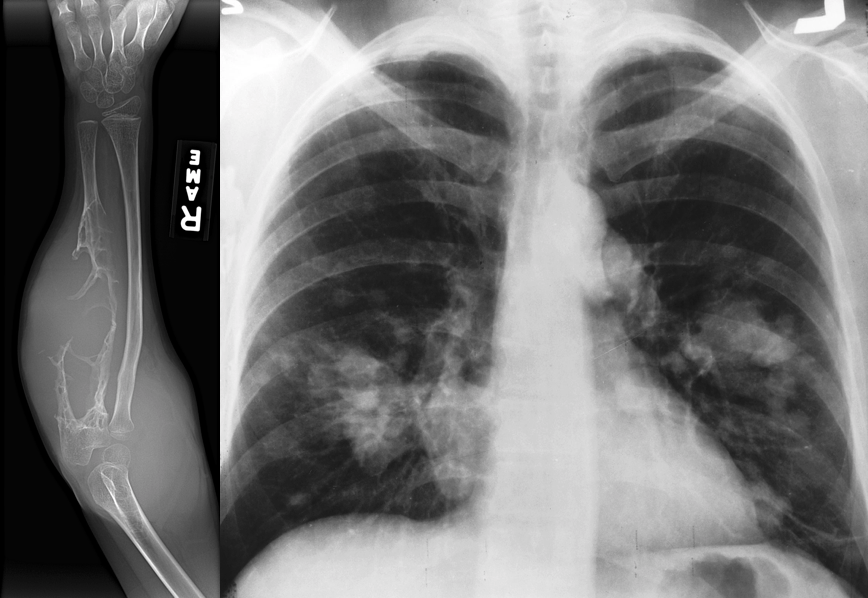

The clinical picture is of progressive subacute spinal cord compression, and it may lead to paraplegia. The formation of intramedullary tuberculomas is rare, with a ratio of two cases per thousand diagnosed with CNS tuberculosis, and the thoracic spine is most frequently affected. Surgical excision was performed, confirming the diagnosis of intramedullary tuberculoma. These characteristics differ from those usually described for intramedullary tuberculomas. The MRI showed two intramedullary nodular lesions at T4–T6 levels, isointense with annular hyperintensity on T1W, hypointense on T2W, becoming hypointense with ring enhancement after contrast. We present a case of a 13-year-old patient in treatment for tuberculous meningitis who presented with progressive paraparesis. Despite advances in treatment, resistant strains and unusual sites of involvement have been diagnosed. In triple rule-out studies, high pitch 128-DSCT delivers a lower dose of radiation and provides better image quality than retrospective acquisition with 64-MDCT.Tuberculosis is a chronic bacterial infection caused by Mycobacterium tuberculosis. 001), and the ED in 128-DSCT was lower than in 64-MDCT (13.77 ± 4 vs. There were fewer artifacts in the coronary arteries on 128-DSCT than on 64-MDCT (3 vs.


01), and in the coronary arteries (VDNR: 25.9 ± 8.2 vs. 01), in the pulmonary arteries (VDNR: 25.5 ± 10 vs. The VDNR and CNR were higher on 128-DSCT than on 64-MDCT in the aorta (VDNR: 28.9 ± 11.7 vs. There were no significant differences between 128-DSCT and 64-MDCT in the vascular density. We estimated the effective dose (ED) of radiation by means of the dose-length product. We qualitatively evaluated the artifacts in the vena cava, aorta, and coronary arteries. We quantitatively analyzed the image quality by calculating the vascular density, muscular density (DM), noise, vascular density/noise ratio (VDNR), and contrast/noise ratio (CNR). We retrospectively studied 60 patients with acute chest pain: 30 with a retrospective EKG acquisition with 64-MDCT and 30 with high pitch 128-DSCT. To compare the image quality and radiation dose from high pitch dual source CT (128-DSCT) versus those from retrospective acquisition with 64-row multidetector CT (64-MDCT) in triple rule-out studies. ConclusiónĮl pitch alto en el triple descarte disminuye la dosis de radiación y mejora la calidad de la imagen con respecto a la adquisición retrospectiva con 64-TCMD. Los artefactos coronarios (3 y 34 segmentos no diagnósticos p < 0,001) y la DRE (13,77 ± 4 y 2,77 ± 0,6 mSv p < 0,001) fueron menores con 128-TCDF. No hubo diferencias significativas en la DV. Calculamos la dosis de radiación efectiva estimada (DRE) con el producto dosis-longitud. Valoramos cualitativamente los artefactos en la vena cava, aorta y coronarias. Analizamos cuantitativamente la calidad de la imagen calculando la densidad vascular (DV), densidad muscular (DM), ruido y cocientes densidad vascular/ruido (CDVR) y contraste/ruido (CCR). Material y métodosĮstudiamos retrospectivamente 60 pacientes con dolor torácico agudo: 30 con una adquisición ECG-retrospectiva con 64-TCMD y 30 con 128-TCDF y pitch alto. Comparar la calidad de imagen y dosis de radiación de la TC de doble fuente (128-TCDF) con pitch alto y la adquisición retrospectiva con TC de 64 filas de detectores (64-TCMD) en estudios de triple descarte.


 0 kommentar(er)
0 kommentar(er)
